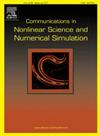Dynamical analysis of a parabolic–hyperbolic hybrid model for species with distinct dispersal and sedentary stages
IF 3.4
2区 数学
Q1 MATHEMATICS, APPLIED
Communications in Nonlinear Science and Numerical Simulation
Pub Date : 2025-05-05
DOI:10.1016/j.cnsns.2025.108907
引用次数: 0
Abstract
Most marine and plant species exhibit two main life stages: a dispersing stage and a sedentary stage. These stages significantly influence the species’ spatial distribution and abundance patterns. To accurately depict the spatial patterns of these species, this paper investigates a hybrid system that combines parabolic and hyperbolic elements, effectively differentiating between the dispersal and sedentary stages. Further spatiotemporal dynamical analysis is conducted to comprehend the large-scale distribution patterns and geographic ranges. Specifically, the model is reformulated into a time-delayed nonlocal system. The existence of spreading speed and its alignment with the minimal wave speed for monotone traveling waves are confirmed for unbounded spatial domains. Meanwhile, a threshold-type result is observed regarding the global attractiveness of the zero or positive steady state for bounded domains. Conditions for population persistence and extinction under both Neumann and Dirichlet boundary conditions are derived. It is further established that the persistence or extinction of the population may be determined by a critical domain size under Dirichlet boundary conditions. Numerical simulations are conducted to provide additional quantitative results, complementing the theoretical findings.
具有不同分散和定居阶段的物种抛物-双曲混合模型的动力学分析
大多数海洋和植物物种表现出两个主要的生命阶段:分散阶段和定居阶段。这些阶段显著影响着物种的空间分布和丰度格局。为了准确地描述这些物种的空间格局,本文研究了一个结合抛物线和双曲线元素的杂交系统,有效地区分了分散阶段和定居阶段。进一步进行时空动态分析,了解其大尺度分布格局和地理范围。具体来说,该模型被重新表述为一个时滞非局部系统。在无界空间域中,证实了单调行波传播速度的存在及其与最小波速的对准。同时,对于有界域的零或正稳态的全局吸引力,观察到一个阈值型结果。在诺依曼边界条件和狄利克雷边界条件下,导出了种群持续和灭绝的条件。进一步证明了在Dirichlet边界条件下,种群的持续或灭绝可以由临界区域大小决定。进行了数值模拟,以提供额外的定量结果,补充理论研究结果。
本文章由计算机程序翻译,如有差异,请以英文原文为准。
求助全文
约1分钟内获得全文
求助全文
来源期刊

Communications in Nonlinear Science and Numerical Simulation
MATHEMATICS, APPLIED-MATHEMATICS, INTERDISCIPLINARY APPLICATIONS
CiteScore
6.80
自引率
7.70%
发文量
378
审稿时长
78 days
期刊介绍:
The journal publishes original research findings on experimental observation, mathematical modeling, theoretical analysis and numerical simulation, for more accurate description, better prediction or novel application, of nonlinear phenomena in science and engineering. It offers a venue for researchers to make rapid exchange of ideas and techniques in nonlinear science and complexity.
The submission of manuscripts with cross-disciplinary approaches in nonlinear science and complexity is particularly encouraged.
Topics of interest:
Nonlinear differential or delay equations, Lie group analysis and asymptotic methods, Discontinuous systems, Fractals, Fractional calculus and dynamics, Nonlinear effects in quantum mechanics, Nonlinear stochastic processes, Experimental nonlinear science, Time-series and signal analysis, Computational methods and simulations in nonlinear science and engineering, Control of dynamical systems, Synchronization, Lyapunov analysis, High-dimensional chaos and turbulence, Chaos in Hamiltonian systems, Integrable systems and solitons, Collective behavior in many-body systems, Biological physics and networks, Nonlinear mechanical systems, Complex systems and complexity.
No length limitation for contributions is set, but only concisely written manuscripts are published. Brief papers are published on the basis of Rapid Communications. Discussions of previously published papers are welcome.
 求助内容:
求助内容: 应助结果提醒方式:
应助结果提醒方式:


